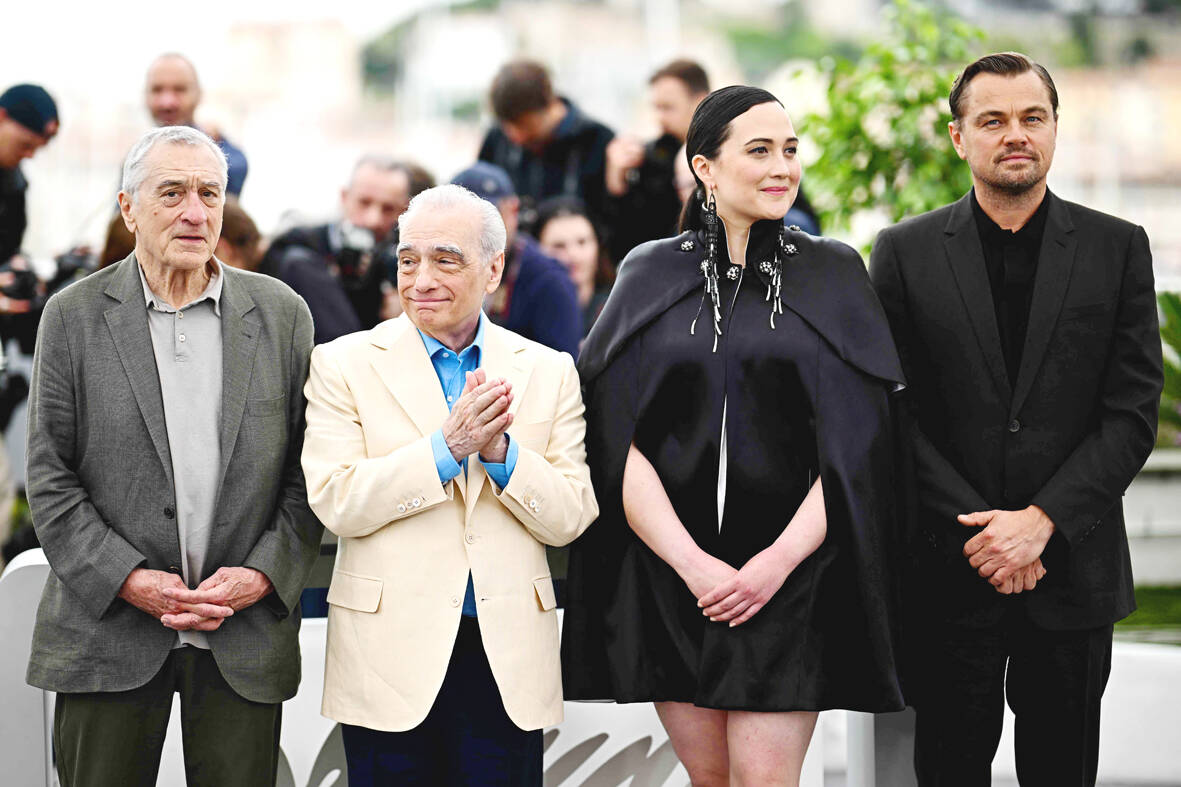It was well into the process of making Killers of the Flower Moon that Martin Scorsese realized it wasn’t a detective story.
Scorsese, actor Leonardo DiCaprio and screenwriter Eric Roth had many potential avenues in adapting David Grann’s expansive nonfiction history, Killers of the Flower Moon: The Osage Murders and the Birth of the FBI. The film that Scorsese and company premiered Saturday at the Cannes Film Festival, however, wasn’t like the one they initially set out to make.
The film, which will open in theaters in October, chronicles the series of killings that took place throughout the Osage Nation in 1920s Oklahoma. The Osage were then enormously rich from oil on their land, and many white barons and gangsters alike sought to control and steal their money. Dozens of Osage Native Americans were killed before the FBI, in its infancy, began to investigate.

Photo: AFP
DiCaprio had originally been cast to star as FBI agent Tom White. But after mulling the project over, Scorsese decided to pivot.
“I said, ‘I think the audience is ahead of us,” Scorsese told reporters in Cannes on Sunday. “They know it’s not a whodunit. It’s a who-didn’t-do-it.”
The shift, filmmakers said, was largely driven from collaboration with the Osage. Osage Nation Chief Standing Bear, who consulted on the film, praised the filmmakers for centering the story instead on Mollie (Lily Gladstone) and her husband Ernest Burkhart (DiCaprio), the tragic romance at the heart of Scorsese’s epic of insidious American ethnic exploitation.
“Early on, I asked Mr. Scorsese, ‘How are you going to approach the story? He said I’m going to tell a story about trust, trust between Mollie and Ernest, trust between the outside world and the Osage and the betrayal of those trusts,” said Chief Standing Bear. “My people suffered greatly and to this very day those effects are with us. But I can say on behalf of the Osage, Marty Scorsese and his team have restored trust and we know that trust will not be betrayed.”
Killers of the Flower Moon, the most anticipated film to debut at this year’s Cannes, instead became about Ernest, who Scorsese called “the character the least is written about.”
DiCaprio, who ceded the character of White to Jesse Plemons, said Killers of the Flower Moon reverberates with other only recently widely discussed dark chapters of American history.
“This story, much like the Tulsa massacre, has been something that people have started to learn about and started to understand is part of culture, part of our history,” said DiCaprio. “After the screenplay, from almost an anthropological perspective — Marty was there everyday — we were talking to the community, trying to hear the real stories and trying to incorporate the truth.”
Killers of the Flower Moon premiered Saturday to largely rave reviews and thunderous applause nearly 50 years after Scorsese, as a young filmmaker, was a sensation at Cannes. His Taxi Driver won the Palme d’Or in 1976.
Among the most-praised performances has been that of Gladstone, the actor of Blackfeet and Nimiipuu heritage.
“These artistic souls on this stage here cared about telling a story that pierces the veil of what society tells us we’re supposed to care about and not,” said Gladstone, who singled out Scorsese. “Who else is going to challenge people to challenge their own complicity in white supremacy in such a platform except as this man here?”
“We’re speaking of the 1920s Osage community. We’re talking about Black Wall Street and Tulsa. We’re talking about a lot in our film,” she continued. “Why the hell does the world not know about these things? Our communities always have. It’s so central to everything about how we understand our place in the world.”
In the film, Robert De Niro plays a wealthy baron who’s particularly adept at plundering the Osage. Speaking on Sunday, De Niro was still mulling his character’s motivations.
“There’s a kind of feeling of entitlement,” said De Niro. “It’s the banality of evil. It’s the thing that we have to watch out for. We see it today, of course. We all know who I’m going to talk about but I won’t say the name. Because that guy is stupid. Imagine if you’re smart?”
A minute later, De Niro resumed: “I mean, look at Trump,” referring to former President Donald Trump.
With a running time well over three hours and a budget from Apple of US$200 million, Killers of the Flower Moon is one of Scorsese’s largest undertakings. Asked where he gets the gumption for such risks, the 80-year-old director didn’t hesitate.
“As far as taking risks at this age, what else can I do?” said Scorsese. “‘No, let’s go do something comfortable.’ Are you kidding?”

June 9 to June 15 A photo of two men riding trendy high-wheel Penny-Farthing bicycles past a Qing Dynasty gate aptly captures the essence of Taipei in 1897 — a newly colonized city on the cusp of great change. The Japanese began making significant modifications to the cityscape in 1899, tearing down Qing-era structures, widening boulevards and installing Western-style infrastructure and buildings. The photographer, Minosuke Imamura, only spent a year in Taiwan as a cartographer for the governor-general’s office, but he left behind a treasure trove of 130 images showing life at the onset of Japanese rule, spanning July 1897 to

One of the most important gripes that Taiwanese have about the Democratic Progressive Party (DPP) is that it has failed to deliver concretely on higher wages, housing prices and other bread-and-butter issues. The parallel complaint is that the DPP cares only about glamor issues, such as removing markers of Chinese Nationalist Party (KMT) colonialism by renaming them, or what the KMT codes as “de-Sinification.” Once again, as a critical election looms, the DPP is presenting evidence for that charge. The KMT was quick to jump on the recent proposal of the Ministry of the Interior (MOI) to rename roads that symbolize

On the evening of June 1, Control Yuan Secretary-General Lee Chun-yi (李俊俋) apologized and resigned in disgrace. His crime was instructing his driver to use a Control Yuan vehicle to transport his dog to a pet grooming salon. The Control Yuan is the government branch that investigates, audits and impeaches government officials for, among other things, misuse of government funds, so his misuse of a government vehicle was highly inappropriate. If this story were told to anyone living in the golden era of swaggering gangsters, flashy nouveau riche businessmen, and corrupt “black gold” politics of the 1980s and 1990s, they would have laughed.

In an interview posted online by United Daily News (UDN) on May 26, current Chinese Nationalist Party (KMT) Chairman Eric Chu (朱立倫) was asked about Taichung Mayor Lu Shiow-yen (盧秀燕) replacing him as party chair. Though not yet officially running, by the customs of Taiwan politics, Lu has been signalling she is both running for party chair and to be the party’s 2028 presidential candidate. She told an international media outlet that she was considering a run. She also gave a speech in Keelung on national priorities and foreign affairs. For details, see the May 23 edition of this column,